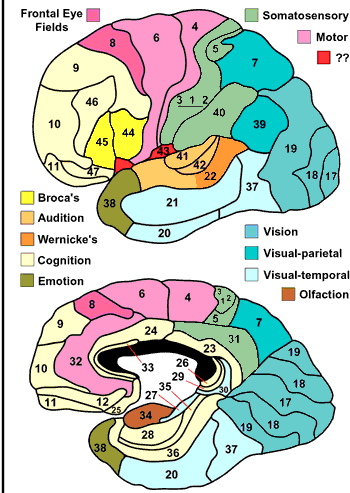
A.3 Brodmann's Classification System
Studies done by Brodmann in the early part of the twentieth century generated a map (Figure A.4) of the cortex covering the lobes of each hemisphere. These studies involved electrical probing of the cortices of epileptic patients during surgery. Brodmann numbered the areas that he studies in each lobe and recorded the psychological and behavioural events that accompanied their stimulation.

The Frontal Lobe contains areas that Brodmann identified as involved in cognitive functioning and in speech and language.
� Area 4 corresponds to the precentral gyrus or primary motor area.
� Area 6 is the premotor or supplemental motor area.
� Area 8 is anterior of the premotor cortex. It facilitates eye movements and is involved in visual reflexes as well as pupil dilation and constriction.
� Areas 9, 10, and 11 are anterior to area 8. They are involved in cognitive processes like reasoning and judgement which may be collectively called biological intelligence.
� Area 44 is Broca's area.
Areas in the Parietal Lobe play a role in somatosensory processes.
� Areas 3, 2, and 1 are located on the primary sensory strip, with area 3 being superior to the other two. These are somastosthetic areas, meaning that they are the primary sensory areas for touch and kinesthesia.
� Areas 5, 7, and 40 are found posterior to the primary sensory strip and correspond to the presensory to sensory association areas.
� Area 39 is the angular gyrus.
Areas involved in the processing of auditory information and semantics as well as the appreciation of smell are found in the Temporal Lobe .
� Area 41 is the primary auditory area.
� Area 42 immediately inferior to area 41 and is also involved in the detection and recognition of speech. The processing done in this area of the cortex provides a more detailed analysis than that done in area 41.
� Areas 21 and 22 are the auditory association areas. Both areas are divided into two parts; one half of each area lies on either side of area 42.
� Area 37 is found on the posterior-inferior part of the temporal lobe.
The Occipital Lobe contains areas that process visual stimuli.
� Area 17 is the primary visual area.
� Areas 18 and 19 are the secondary visual areas.